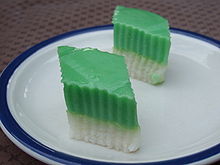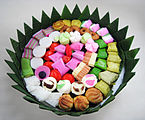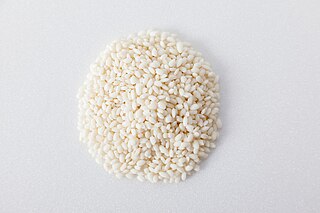
Glutinous rice is a type of rice grown mainly in Southeast and East Asia, Northeastern India and Bhutan which has opaque grains, very low amylose content, and is especially sticky when cooked. It is widely consumed across Asia.

Malay cuisine is the traditional food of the ethnic Malays of Southeast Asia, residing in modern-day Malaysia, Indonesia, Singapore, Brunei, Southern Thailand and the Philippines as well as Cocos Islands, Christmas Island, Sri Lanka and South Africa.

Coconut jam is a jam made from a base of coconut milk, eggs and sugar. It is popular in Southeast Asia, mainly in Brunei, Indonesia, Malaysia, the Philippines, Singapore and Thailand.

Kuih are bite-sized snack or dessert foods commonly found in Southeast Asia. It is a fairly broad term which may include items that would be called cakes, cookies, dumplings, pudding, biscuits, or pastries in English and are usually made from rice or glutinous rice. The term kuih is widely used in Malaysia, Brunei, and Singapore, and kueh or kue is used in Indonesia, to refer to sweet or savoury desserts. Though called by other names, one is likely to find various similar versions of kuih in neighbouring countries, such as Vietnam, Thailand, and Myanmar. For example, the colourful steamed kue lapis and the rich kuih bingka ubi are also available in Myanmar, Thailand, and Vietnam. In the Philippines, kuih are referred to in Tagalog as kakanin.
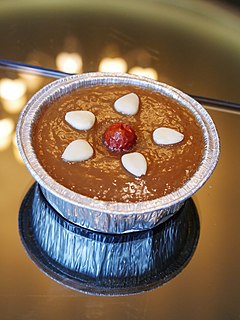
Nian gao, sometimes translated as year cake or New Year cake or Chinese New Year's cake, is a food prepared from glutinous rice flour and consumed in Chinese cuisine. It is also simply known as "rice cake". While it can be eaten all year round, traditionally it is most popular during the Chinese New Year. It is considered good luck to eat nian gao (年糕) during this time of the year because nian gao (年糕) is a homonym for "higher year" or "grow every year" (年高), which means "a more prosperous year". The character 年 is literally translated as "year", and the character 糕 (gāo) is literally translated as "cake" and is identical in sound to the character 高, meaning "tall" or "high". Nian gao (年糕) also has the exact homonym for "sticky cake" (粘糕); the character 粘 (nián), meaning "sticky".
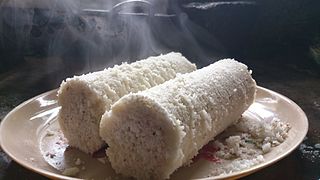
Puttu is a breakfast dish eaten in the South Indian states of Kerala, Tamil Nadu and parts of Karnataka, as well as Sri Lanka. Puttu means "portioned" in Tamil and Malayalam. It is made of steamed cylinders of ground rice layered with coconut shavings, sometimes with a sweet or savory filling on the inside. Puttu is served hot with sweet side dishes such as palm sugar or banana, or with curries including dal, chickpea, mutton, fish, chicken, or beef curry.

A rice cake may be any kind of food item made from rice that has been shaped, condensed, or otherwise combined into a single object. A wide variety of rice cakes exist in many different cultures in which rice is eaten and are particularly prevalent in Asia. Common variations include cakes made with rice flour, those made from ground rice, and those made from whole grains of rice compressed together or combined with some other binding substance.

Cendol is an iced sweet dessert that contains droplets of green rice flour jelly, coconut milk and palm sugar syrup. It is commonly found in Southeast Asia and is popular in Indonesia, Malaysia, Brunei, Cambodia, East Timor, Laos, Vietnam, Thailand, Singapore, and Myanmar. Next to the green jelly, additional toppings might be added, including diced jackfruit, sweetened red azuki beans, or durian.

Kue is an Indonesian bite-sized snack or dessert food. Kue is a fairly broad term in Indonesian to describe a wide variety of snacks; cakes, cookies, fritters, pies, scones, and patisserie. Kue are made from a variety of ingredients in various forms, some are steamed, fried or baked. Kue are popular snacks in Indonesia, which has the largest variety of kue. Because of the countries' historical colonial ties, Koeé (kue) is also popular in the Netherlands.

Kue kochi or koci is a Maritime Southeast Asian dumpling found in Javanese, Malay and Peranakan cuisine, made from glutinous rice flour, and stuffed with coconut fillings with palm sugar.
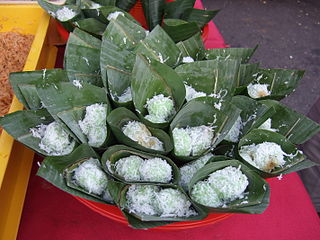
Klepon, or kelepon, is a snack of sweet rice cake balls filled with molten palm sugar and coated in grated coconut. Of Javanese origin, the green-coloured glutinous rice balls are one of the popular traditional kue in Indonesian cuisine. It is also commonly found in neighbouring countries such as Malaysia, Brunei and Singapore as onde-onde.

Kue putu or putu bambu is an Indonesian (kue) traditional cylindrical-shaped and green-colored steamed cake. The cake is made of rice flour called suji and coloured green with extract acquired from pandan leaf, filled with palm sugar, and steamed in bamboo tubes, hence its name, and served with grated coconut. This traditional bite-size snack is commonly found in maritime Southeast Asia, particularly in Java, Indonesia, where the cake is called putu bumbung. Kue putu can also be found in the Netherlands due to its colonial ties with the Dutch East India with Indonesia.

Betawi cuisine is rich, diverse and eclectic, in part because the Betawi people that create them were composed from numbers of regional immigrants that came from various places in the archipelago, as well as Chinese, Indian, Arab, and European traders, visitors and immigrants that were attracted to the port city of Batavia since centuries ago.

Bolu kukus is an Indonesian and Malaysian traditional snack of steamed sponge cupcake. The term "bolu kukus" however, usually refer to a type of kue mangkuk that mainly only uses wheat flour with sugar, eggs, milk, soda, and also using common vanilla, chocolate, pandan or strawberry flavouring, acquired from food flavouring essence. The cake uses beaten eggs and soda as emulsifier, the type of soda being lemon sparkling water, usually Sprite.

Khao niao sangkhaya or sticky rice with custard, is a traditional Thai dessert. It is prepared with glutinous rice, topped with coconut custard and coconut milk. Khao niao sangkhaya is served warm or at room temperature. The dessert is also found in other countries in Southeast Asia, such as Indonesia, Malaysia, Singapore, and the Philippines.

Palembangese cuisine is the cuisine of the Palembangese people of the city of Palembang in the South Sumatra province of Indonesia. It is the second most well-known cuisine from Sumatra after Padang.

Milk pie is an Indonesian custard tart pastry consisting of a shortcrust pastry filled with egg custard and condensed milk. This traditional Indonesian dessert pastry is very flat with only one very thin layer of custard. The origin of this pastry is from Bali.

Banjarese cuisine is the cooking tradition and cuisine of Banjar people of South Kalimantan in Indonesia. Banjar cuisine also found in neighbor countries as following Brunei, Malaysia to Singapore.
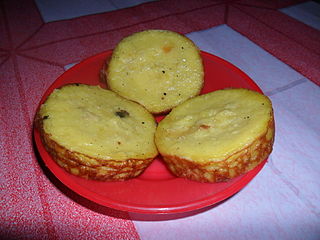
Kue bingka is an Indonesian traditional cake that is one of the typical traditional Banjar kue mostly associated with South Kalimantan province, Indonesia. Kue bingka also found in Malay cuisine. It has very sweet, fat and soft texture. Kue bingka is one of the cakes used in the Banjar tradition to serve 41 types of cakes for special occasions such as weddings. Although it can be found throughout the year, kue bingka is usually common in Ramadan due to it is considered suitable for iftar.
